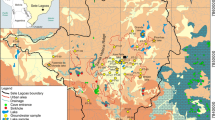Abstract
A karst-fissured aquifer in the Upper Jurassic carbonate rocks of the Krakow Upland shows a very high yield (safe yield 117 000 m3/day) and belongs to the major groundwater basins (MGBs) of Poland. The uncovered character of the aquifer and its hydraulic structure favor the intensive infiltration and migration of anthropogenic pollutants from the surface. This pollution is caused by agriculture and industry in the proximity of Krakow and the Upper Silesian agglomeration. Progressive degradation of groundwater quality on a regional scale results. Evaluation of the endangering of the aquifer studied is based on the analysis of the time interval of vertical water percolation from the surface, the time interval of groundwater horizontal flow through the aquifer and the duration of water residence in the aquifer derived from tritium data. Quaternary and Cretaceous overburden occur in the Krakow Upland in addition to numerous outcrops of limestones. The time interval of vertical water percolation in highly permeable limestones does not exceed 3 years and in the areas covered by overburden it is from several to 50 years. The mean effective time interval of horizontal groundwater flow through the Upper Jurassic rocks along the flow paths ranges from several months in the areas of direct drainage to over 15 years in the elevated areas of local groundwater divides. The age of water in the rock matrix was determined using tritium data interpreted according to an exponential model and it ranges from 70 years to over 130 years. In karst-fissured systems with a high retardation index (Rp=21) the effective time of water circulation in local drainage basins does not exceed 7 years.
The Krakow-Wieluń Upland is the most extensive and uniform karst region in Poland. It is a belt of Upper Jurassic limestone extending from Krakcow in the southeast to Wieluń in the northwest on the northeast slope of the Silesian Upland. Residual hills of Paleogene age separated by infilled karst depressions are the most characteristic features of the Krakow-Wieluń Upland. More than 800 small caves are known in this area, but only two of them reach 1 km of aggregate passage length (Gazek and others 1992).
Similar content being viewed by others
Author information
Authors and Affiliations
Additional information
Received: 4 December 1996 · Accepted: 29 April 1997
Rights and permissions
About this article
Cite this article
Rózkowski, J. Endangering of the Upper Jurassic karst-fissured aquifer in the Krakow Upland (southern Poland). Environmental Geology 33, 274–278 (1998). https://doi.org/10.1007/s002540050246
Issue Date:
DOI: https://doi.org/10.1007/s002540050246




